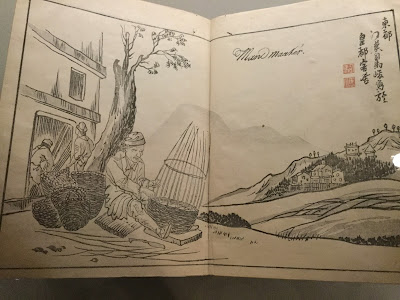On Nov. 28, 1777, Goethe wrote in his diary: "besorgt ich noch aller ley." What is being referred to are his preparations for a long trip, which began the next day, Nov. 29, and which would continue until December 15. He was traveling by horse, and stopped in such places as Greußen, Ilfeld, Elbingerode, Baumannshöhle, Wernigerode, Goslar, Clasthal, Altenau, and Eisenach. (Some of these are so small that they are not captured on images of the Harz mountains.) The high point of this journey would be his Brocken expedition, leading him, in the middle of winter, to ascend on Dec. 10 the high peak of the Brocken, of which it was said that no one climbed it in winter. On Dec. 12 he noted in his diary that he was working on the poem that would become known as "Harzreise im Winter."
Because the diary entry for November 29 is so long, I will not post it on the Goethe Twitter feed, but instead will break up here the contents of that day, which was quite a journey itself. First the setting off during a hailstorm (Schlossen), but feeling peaceful:
Früh gegen sieben ab übern Ettersberg in scharfen Schlossen 20 Min. auf 1 in Weissensee. stürmisch gebrochen Wetter, reine Ruh in der Seele, Sonnenblicke mit unter Abends nach 4 in Greusen.
In Greusen he decided to stop. The commentary to Goethe's diary makes it sound as if Goethe hears an anecdote from a teamster (Fuhrmann) he met there about a preacher (Seelsorger) who (apparently) sent a load to 3 blacksmiths who didn't wish to shoe it because it was too big. (This is a total guess: please correct me who knows what it is meant here. The diary commentary volume is not very revealing):
Musste schon Halt machen es brach die Nacht ein. NB. Wie der Furhmann erzählt von seinem Seelsorger wie der ein Maas zu 3 Schmieden schikt dies nicht beschlagen wollends so gros ist. Aber er wills so haben.
In any case, the anecdote ends with a Biblical reference (Deut. 25, 14: Thou shalt not have in thy bag divers weights, a great and a small):
Wenn wird der zehende aufhören und ein Epha -- ich weiss wohl was steht.
The diary for December 1 is even longer. It describes a very arduous journey:
Sonnt. früh nach sechsen von Greusen mit einem Boten ab. War scharf gefroren und die Sonne ging mit herrlichsten Farben an. Ich sah den Ettersberg, den Inselsberg, die Berge des Thüringer Waldes hinter mir. dann in Wald und im heraustreten, Sondershausen das sehr angenehm liegt. Die Spizze des Brockens einen Augenblick, hinter Sondershausen weg auf Sundhausen Schöne Aussicht die goldne Aue vom Kyffhauser bis Northhausen herauf.Mit einigen Invaliden die ihre Pension in Ilefeld hohlten. Fütterte in Sundhausen. Dann bey Northhausen weg. es hatte schon gegen Mittag zu regnen angefangen. Die Nacht kam leise und traruig. Auf Sachswerben, wo ich einen Boten mit einer Laterne nehmen musste, um durch die tiefe Finsterniss hierher Ilefeld zu kommen. Fand keine Stube leer. Sizze im Kämmergen neben der Wirthsstube. War den ganzen Tag in gleicher Reinheit.
I have posted this early portion of the diary and will continue with further stops on the route on the Twitter feed, after which I plan to post on the interpretation of Goethe's Harz poem and my own thoughts.







